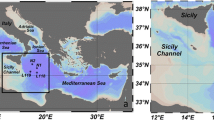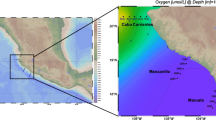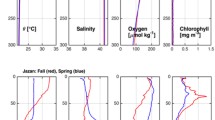Abstract
Micro-organisms are vital for the functioning of all food webs and are the major drivers of the global biogeochemical cycles. The microbial community compositions and physicochemical conditions of the different water masses in the North Sea, a biologically productive sea on the northwestern European continental shelf, were studied during two summer cruises, in order to provide detailed baseline data for this region and examine its microbial biogeography. For each cruise the stations were clustered according to their physicochemical characteristics and their microbial community composition. The largest cluster, which covered most of the central and northern North Sea, consisted of stations that were characterized by a thermally stratified water column and had low chlorophyll a autofluorescence and generally low microbial abundances. The second main cluster contained stations that were dominated by picoeukaryotes and showed the influence of influxes of North Atlantic water via the English Channel and south of the Shetland Islands. The third main cluster was formed by stations that were dominated by cyanobacteria and nanoeukaryotes in the reduced salinity Norwegian Coastal and Skagerrak waters, while the fourth cluster represented the German Bight, a region with strong riverine input, high nutrient concentrations, and consequently high heterotrophic bacterial and viral abundances. Despite the complex and dynamic hydrographic nature of the North Sea, the consistent distinctions in microbiology between these different hydrographic regions during both cruises illustrate the strong links between the microbial community and its environment, as well as the possibility to use microorganisms for long-term monitoring of environmental change.









Similar content being viewed by others
References
Anderson MJ, Gorley RN, Clarke KR (2008) PERMANOVA+ for PRIMER: guide to software and statistical methods. PRIMER-E, Plymouth
Baudoux AC, Noordeloos AAM, Veldhuis MJW, Brussaard CPD (2006) Virally induced mortality of Phaeocystis globosa during two spring blooms in temperate coastal waters. Aquat Microb Ecol 44:207–217
Baudoux AC, Veldhuis MJW, Witte HJ, Brussaard CPD (2007) Viruses as mortality agents of picophytoplankton in the deep chlorophyll maximum layer during IRONAGES III. Limnol Oceanogr 52:2519–2529
Baudoux AC, Veldhuis MJW, Noordeloos AAM, Van Noort G, Brussaard CPD (2008) Estimates of virus- vs. grazing induced mortality of picophytoplankton in the North Sea during summer. Aquat Microb Ecol 52:69–82
Brussaard CPD (2004) Optimization of procedures for counting viruses by flow cytometry. Appl Environ Microbiol 70:1506–1513
Brussaard CPD, Kuipers B, Veldhuis MJW (2005) A mesocosm study of Phaeocystis globosa population dynamics. I. Regulatory role of viruses in bloom control. Harmful Algae 4:859–874
Brussaard CPD, Payet JP, Winter C, Weinbauer MG (2010) Quantification of aquatic viruses by flow cytometry. In: Wilhelm SW, Weinbauer MG, Suttle CA (eds) Manual of aquatic viral ecology. ASLO, Waco, pp 102–109
Charnock H, Dyer KR, Huthnance JM, Liss PS, Simpson BH (1994) Understanding the North Sea system. Chapman & Hall for the Royal Society, London/New York
Clarke KR, Gorley RN (2006) PRIMER v6: user manual/tutorial. PRIMER-E, Plymouth
Danovaro R, Corinaldesi C, Dell’Anno A, Fuhrman JA, Middelburg JJ, Nobel RT, Suttle CA (2010) Marine viruses and global climate change. FEMS Microbiol Rev 35:1–42
Ducrotoy J-P, Elliot M, De Jonge VN (2000) The North Sea. Mar Pollut Bull 41:5–23
Edwards M, Beaugrand G, Reid PC, Rowden AA, Jones MB (2002) Ocean climate anomalies and the ecology of the North Sea. Mar Ecol Prog Ser 239:1–10
Evans C, Thomson PG, Davidson AT, Bowie AR, Witte H, Brussaard CPD (2011) Potential climate change impacts on microbial distribution and carbon cycling in the Australian Southern Ocean. Deep Sea Res II 58:2150–2161
Fuhrman JA (2009) Microbial community structure and its functional implications. Nature 459:193–199
Gescher C, Metfies K, Frickenhaus S, Knefelkamp B, Wiltshire KH, Medlin LK (2008) Feasibility of assessing the community composition of prasinophytes at the Helgoland Roads sampling site with a DNA microarray. Appl Environ Microbiol 74:5305–5316
Grasshoff K (1983) Determination of nitrate, nitrate, oxygen, thiosulphate. In: Grasshoff K, Ehrhardt M, Kremling K (eds) Methods of seawater analysis. Verlag Chemie, Weinheim, pp 61–72, 81–84, 139–142, 143–150
Hays GC, Richardson AJ, Robinson C (2005) Climate change and marine plankton. Trends Ecol Evol 20:337–344
Helder W, De Vries RTP (1979) An automated phenol-hypochlorite method for the determination of ammonia in sea- and brackish waters. Neth J Sea Res 13:154–160
Hoppe H-G, Breithaupt P, Walther K, Koppe R, Bleck S, Sommer U, Jürgens K (2008) Climate warming in winter affects the coupling between phytoplankton and bacteria during the spring bloom: a mesocosm study. Aquat Microb Ecol 51:105–115
Kirkham AR, Jardillier LE, Holland R, Zubkov MV, Scanlan DJ (2011) Analysis of photosynthetic picoeukaryote community structure along an extended Ellet Line transect in the northern North Atlantic reveals a dominance of novel prymnesiophyte and prasinophyte phylotypes. Deep Sea Res I 58:733–744
Kritzberg ES, Duarte CM, Wassmann P (2010) Changes in Antarctic marine bacterial carbon metabolism in response to increasing temperature. Polar Biol 33:1673–1682
Lepère C, Vaulot D, Scanlan DJ (2009) Photosynthetic picoeukaryotes community structure in the South East Pacific Ocean encompassing the most oligotrophic waters on Earth. Environ Microbiol 11:3105–3117
Li Shi X, Lepère C, Scanlan DJ, Vaulot D (2011) Plastid 16S rRNA gene diversity among eukaryotic picophytoplankton sorted by flow cytometry from the South Pacific Ocean. PLoS One 6:1–13
Mackey MD, Mackey DJ, Higgins HW, Wright SW (1996) CHEMTAX—a program for estimating class abundances from chemical markers: application to HPLC measurements of phytoplankton. Mar Ecol Prog Ser 144:265–283
Marie D, Brussaard CPD, Partensky F, Vaulot D (1999) Enumeration of phytoplankton, bacteria and viruses in marine samples. In: Robinson ZD, Dean PN, Orfao A et al (eds) Current protocols in cytometry. Wiley, New York, pp 11.11.11–11.11.15
Masquelier S, Foulon E, Jouenne F, Ferreol M, Brussaard CPD, Vaulot D (2011) Distribution of eukaryotic plankton in the English Channel and the North Sea in summer. J Sea Res 66:111–122
Metfies K, Gescher C, Frickenhaus S, Niestroy R (2010) Contribution of the class Cryptophyceae to phytoplankton structure in the German Bight. J Phycol 46:1152–1160
Murphy J, Riley JP (1962) A modified single solution method for the determination of phosphate in natural waters. Anal Chim Acta 27:31–33
Not F, Latasa M, Marie D, Cariou T, Vaulot D, Simon N (2004) A single species, Micromonas pusilla (Prasinophyceae), dominates the eukaryotic picoplankton in the Western English Channel. Appl Environ Microbiol 70:4064–4072
Otto L, Zimmerman JTF, Furnes GK, Mork M, Saetre R, Becker G (1990) Review of the physical oceanography of the North Sea. Neth J Sea Res 26:61–238
Parada P, Herndl GJ, Weinbauer MG (2006) Viral burst size of heterotrophic prokaryotes in aquatic systems. J Mar Biol Assoc UK 86:613–621
Partensky F, Blanchot J, Vaulot D (1999) Differential distribution and ecology of Prochlorococcus and Synechococcus in oceanic waters: a review. In: Charpy L, Larkum AWD (eds) Marine cyanobacteria. Bull Inst Oceanogr Monaco, special volume 19, pp 457–475
Ramette A (2007) Multivariate analyses in microbial ecology. FEMS Microbiol Ecol 62:142–160
Riegman R, Kraay GW (2001) Phytoplankton community structure derived from HPLC analysis of pigments in the Faroe–Shetland Channel during summer 1999: the distribution of taxonomic groups in relation to physical/chemical conditions in the photic zone. J Plankton Res 23:191–205
Schlitzer R (2010) Ocean Data View 4.3.2. http://odv.awi.de
Sintes E, Stogeregger K, Parada V, Herndl GJ (2010) Seasonal dynamics of dissolved organic matter and microbial activity in the coastal North Sea. Aquat Microb Ecol 60:85–95
Strickland JDH, Parsons TR (1972) A practical handbook of seawater analysis. In: Fisheries Research Board of Canada, Bulletin 167, Canadian Government Publishing Centre, Ottawa, pp 310
Suttle CA (2005) Viruses in the sea. Nature 437:356–361
Taylor AH, Allen JI, Clark PA (2002) Extraction of a weak climatic signal by an ecosystem. Nature 416:629–632
Thomas H, Bozec Y, Elkalay K, de Baar HJW (2004) Enhanced open ocean storage of CO2 from shelf sea pumping. Science 304:1005–1008
Vaulot D (1989) CYTOPC: processing software for flow cytometric data. Signal Noise 2:8
Weijerman M, Lindeboom H, Zuur AF (2005) Regime shifts in marine ecosystems of the North Sea and Wadden Sea. Mar Ecol Prog Ser 298:21–39
Weston K, Greenwood N, Fernand L, Pearce DJ, Sivyer DB (2008) Environmental controls on phytoplankton community composition in the Thames plume, U.K. J Sea Res 60:246–254
Widdicombe CE, Eloire D, Harbour D, Harris RP, Somerfield PJ (2010) Long-term phytoplankton community dynamics in the Western English Channel. J Plankton Res 32:643–655
Wilhelm SW, Suttle CA (1999) Viruses and nutrient cycles in the sea. Bioscience 49:781–788
Winter C, Herndl GJ, Weinbauer MG (2004) Diel cycles in viral infection of bacterioplankton in the North Sea. Aquat Microb Ecol 35:207–216
Wollast R (1998) Evaluation and comparison of the global carbon cycle in the coastal zone and in the open ocean. In: Brink KH, Robinson AR (eds) The sea. Wiley, New York, pp 152–213
Acknowledgments
We would like to thank the crew on RV Pelagia and the scientific crews of the MICROVIR (64PE217) and CARBOOCEAN (64PE294) cruises. We also thank the NIOZ-Marine Research Facilities (MRF), NIOZ-Marine Technology (MT) and NIOZ-Data Management (DM) for on-shore and on-board support. We are grateful to Harry Witte for his help with the statistical analyses. Financial support for this study was obtained from the Netherlands Organization for Scientific Research (NWO).
Author information
Authors and Affiliations
Corresponding author
Electronic supplementary material
Below is the link to the electronic supplementary material.
Rights and permissions
About this article
Cite this article
Brandsma, J., Martínez, J.M., Slagter, H.A. et al. Microbial biogeography of the North Sea during summer. Biogeochemistry 113, 119–136 (2013). https://doi.org/10.1007/s10533-012-9783-3
Received:
Accepted:
Published:
Issue Date:
DOI: https://doi.org/10.1007/s10533-012-9783-3




